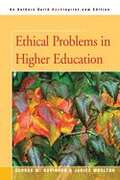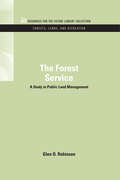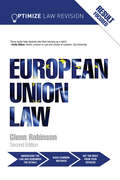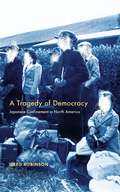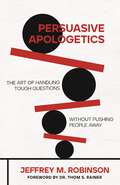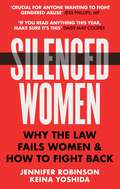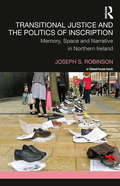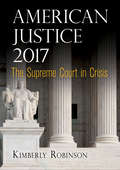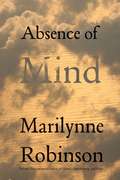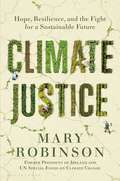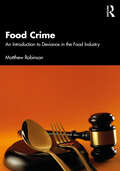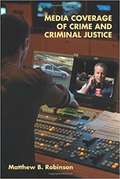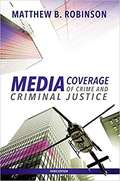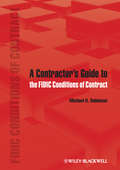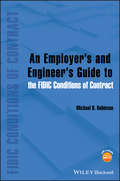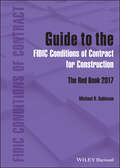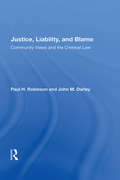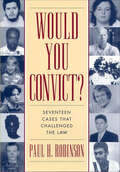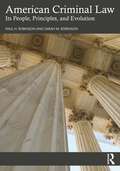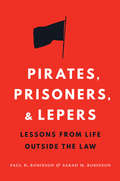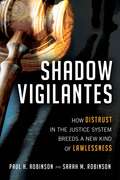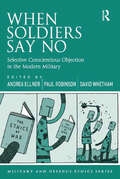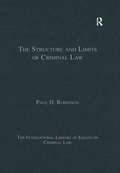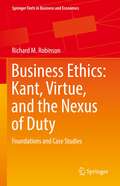- Table View
- List View
Ethical Problems in Higher Education
by George M. Robinson Janice MoultonThe Ivory Tower Myth suggests that the world of higher education has no moral problems. Unlike ethical conflicts in business, politics and medicine, ethical problems in higher education receive little publicity. But devotion to the pursuit of knowledge does not ensure ethical behavior. Power, competition, pressure and lust for recognition create moral conflicts. Some are unique to higher education but many are common to the world off-campus. <p><p> This book uses ethical theories as a tool to analyze real examples from our colleges and universities. Topics include: academic freedom, plagiarism, cheating, research fraud, equal opportunity, evaluation, tenure, student-faculty relationships.
The Forest Service: A Study in Public Land Management (RFF Forests, Lands, and Recreation Set)
by Glen O. RobinsonFirst Published in 2011. Routledge is an imprint of Taylor & Francis, an informa company.
Optimize European Union Law (Optimize)
by Glenn RobinsonThe Optimize series is designed to show you how to apply your knowledge in assessment. These concise revision guides cover the most commonly taught topics, and provide you with the tools to: Understand the law and remember the details using diagrams and tables throughout to demonstrate how the law fits together Contextualise your knowledge identifying and explaining how to apply legal principles for important cases providing cross-references and further reading to help you aim higher in essays and exams Avoid common misunderstandings and errors identifying common pitfalls students encounter in class and in assessment Reflect critically on the law identifying contentious areas that are up for debate and on which you will need to form an opinion Apply what you have learned in assessment presenting learning objectives that reflect typical assessment criteria providing sample essay and exam questions, supported by end-of chapter feedback The series is also supported by comprehensive online resources that allow you to track your progress during the run-up to exams.
A Tragedy of Democracy: Japanese Confinement in North America
by Greg RobinsonThe confinement of some 120,000 Japanese Americans during World War II, often called the Japanese American internment, has been described as the worst official civil rights violation of modern U. S. history. Greg Robinson not only offers a bold new understanding of these events but also studies them within a larger time frame and from a transnational perspective. Drawing on newly discovered material, Robinson provides a backstory of confinement that reveals for the first time the extent of the American government's surveillance of Japanese communities in the years leading up to war and the construction of what officials termed "concentration camps" for enemy aliens. He also considers the aftermath of confinement, including the place of Japanese Americans in postwar civil rights struggles, the long movement by former camp inmates for redress, and the continuing role of the camps as touchstones for nationwide commemoration and debate. Most remarkably, A Tragedy of Democracy is the first book to analyze official policy toward West Coast Japanese Americans within a North American context. Robinson studies confinement on the mainland alongside events in wartime Hawaii, where fears of Japanese Americans justified Army dictatorship, suspension of the Constitution, and the imposition of military tribunals. He similarly reads the treatment of Japanese Americans against Canada's confinement of 22,000 citizens and residents of Japanese ancestry from British Columbia. A Tragedy of Democracy recounts the expulsion of almost 5,000 Japanese from Mexico's Pacific Coast and the poignant story of the Japanese Latin Americans who were kidnapped from their homes and interned in the United States. Approaching Japanese confinement as a continental and international phenomenon, Robinson offers a truly kaleidoscopic understanding of its genesis and outcomes. The confinement of some 120,000 Japanese Americans during World War II, often called the Japanese American internment, has been described as the worst official civil rights violation of modern U. S. history. Greg Robinson not only offers a bold new understanding of these events but also studies them within a larger time frame and from a transnational perspective. Drawing on newly discovered material, Robinson provides a backstory of confinement that reveals for the first time the extent of the American government's surveillance of Japanese communities in the years leading up to war and the construction of what officials termed "concentration camps" for enemy aliens. He also considers the aftermath of confinement, including the place of Japanese Americans in postwar civil rights struggles, the long movement by former camp inmates for redress, and the continuing role of the camps as touchstones for nationwide commemoration and debate. Most remarkably, A Tragedy of Democracy is the first book to analyze official policy toward West Coast Japanese Americans within a North American context. Robinson studies confinement on the mainland alongside events in wartime Hawaii, where fears of Japanese Americans justified Army dictatorship, suspension of the Constitution, and the imposition of military tribunals. He similarly reads the treatment of Japanese Americans against Canada's confinement of 22,000 citizens and residents of Japanese ancestry from British Columbia. A Tragedy of Democracy recounts the expulsion of almost 5,000 Japanese from Mexico's Pacific Coast and the poignant story of the Japanese Latin Americans who were kidnapped from their homes and interned in the United States. Approaching Japanese confinement as a continental and international phenomenon, Robinson offers a truly kaleidoscopic understanding of its genesis and outcomes.
Persuasive Apologetics: The Art of Handling Tough Questions without Pushing People Away
by Jeffrey M. RobinsonWe cannot love others well without speaking the truthLoving our neighbors well includes engaging in robust conversations that destabilize false belief systems. In addressing the mind, will, and emotions of actual, complex people, Christian believers must develop various approaches to meet diverse personalities and multiple connection points. In Persuasive Apologetics, pastor and professor Jeffrey M. Robinson explores what's below the surface of intellectual-sounding objections to Christianity. He shows what it means to contend for the truth through real-life examples of communicating with those who hold differing beliefs. Robinson covers foundational and practical issues, such as • the importance of demeanor in being persuasive • various apologetic approaches • the influence of worldview presuppositions • using undercutting defeaters to expose faulty thinking • causes of nonbelief • the historical Jesus compared with figureheads of competing belief systems • the hope that Jesus offers Persuasive Apologetics will challenge serious seekers to peel back the layers of skeptical arguments and equip committed Christians looking to hone their apologetics skills.
How Many More Women?: The silencing of women by the law and how to stop it
by Jennifer Robinson Keina Yoshida'Compelling... brilliant but shaming.' CHERIE BLAIR, KC'Crucial reading for any person wanting to fight against all forms of gendered abuse.' JESS PHILLIPS, MP'This book is another brick through the windows of our legal systems: a brilliant, trenchant analysis of what is wrong with the law.' HELENA KENNEDY, KC We are in a crucial moment: women are breaking through the cultural reticence around gender-based violence. But just as survivors have begun to feel empowered to speak out, a new form of systematic silencing has made itself more evident: rich and powerful men are using teams of lawyers to suppress allegations and prevent newspaper stories from running. Individual women, advocacy groups and journalists find themselves fighting against censorship. The law is being wielded to reinforce the status quo of silence that existed before #MeToo.If women cannot speak about their abuse - and journalists are fearful of telling their stories - then how can we understand the problem of gender-based violence in our society? And how can we even begin to end it?In How Many More Women? internationally-acclaimed human rights lawyers, Jennifer Robinson and Keina Yoshida, examine the broken systems and explore the changes needed in order to ensure that women's freedom, including their freedom of speech, is no longer threatened by the laws that are supposed to protect them.
Transitional Justice and the Politics of Inscription: Memory, Space and Narrative in Northern Ireland
by Joseph RobinsonTaking Northern Ireland as its primary case study, this book applies the burgeoning literature in memory studies to the primary question of transitional justice: how shall societies and individuals reckon with a traumatic past? Joseph Robinson argues that without understanding how memory shapes, moulds, and frames narratives of the past in the minds of communities and individuals, theorists and practitioners may not be able to fully appreciate the complex, emotive realities of transitional political landscapes. Drawing on interviews with what the author terms "memory curators," coupled with a robust analysis of secondary literature from a range of transitional cases, the book analyses how the bodies of the dead, the injured, and the traumatised are written into - or written out of - transitional justice. The author argues that scholars cannot appreciate the dynamism of transitional memory-space unless they first engage with the often silenced or marginalised voices whose memories remain trapped behind the antagonistic politics of fear and division. Ultimately challenging the imperative of national reconciliation, the author argues for a politics of public memory that incubates at multiple nodes of social production and can facilitate a vibrant, democratic debate over the ways in which a traumatic past can or should be remembered.
American Justice 2017: The Supreme Court in Crisis
by Kimberly RobinsonWith the death of associate justice Antonin Scalia, the Supreme Court was plunged into crisis. Refusing to hold hearings or confirm the nominee of a Democratic president almost a year away from a presidential election, the Republican-controlled Senate held the court hostage, forcing it to do its work through nearly the entire term ending in June 2017 with just eight justices. In American Justice 2017: The Supreme Court in Crisis, Kimberly Robinson examines the way individual justices and the institution as a whole reacted to this unprecedented, politically fraught situation.In public, the justices put on brave faces, waiting for the confirmation battle to play itself out, while indicating in occasional statements that the court would muddle through just fine. In private, though, things appear to have been more complicated. Narrow decisions, lackluster choice of cases, and odd bedfellows teaming up on the same sides of opinions and dissents give us a hint of the strenuous effort the eight justices made to uphold the integrity of the institution in the face of hurricane-force partisan gales.
Absence of Mind: The Dispelling of Inwardness from the Modern Myth of the Self
by Marilynne RobinsonIn this ambitious book, acclaimed writer Marilynne Robinson applies her astute intellect to some of the most vexing topics in the history of human thought--science, religion, and consciousness. Crafted with the same care and insight as her award-winning novels, Absence of Mind challenges postmodern atheists who crusade against religion under the banner of science. In Robinson's view, scientific reasoning does not denote a sense of logical infallibility, as thinkers like Richard Dawkins might suggest. Instead, in its purest form, science represents a search for answers. It engages the problem of knowledge, an aspect of the mystery of consciousness, rather than providing a simple and final model of reality. By defending the importance of individual reflection, Robinson celebrates the power and variety of human consciousness in the tradition of William James. She explores the nature of subjectivity and considers the culture in which Sigmund Freud was situated and its influence on his model of self and civilization. Through keen interpretations of language, emotion, science, and poetry, Absence of Mind restores human consciousness to its central place in the religion-science debate.
Climate Justice: Hope, Resilience, and the Fight for a Sustainable Future
by Mary RobinsonHolding her first grandchild in her arms in 2003, the author was struck by the uncertainty of the world he had been born into. Before his fiftieth birthday, he would share the planet with more than nine billion people-people battling for food, water, and shelter in an increasingly volatile climate. The faceless, shadowy menace of climate change had become, in an instant, deeply personal. This book is a stirring manifesto on one of the most pressing humanitarian issues of our time, affirmative, and well-argued case for hope.
Food Crime: An Introduction to Deviance in the Food Industry
by Matthew RobinsonThis book addresses the various forms of deviance and criminality found within the conventional food system. This system—made up of numerous producers, processors, distributors, and retailers of food—has significant, far-reaching consequences bearing upon the environment and society.Food Crime broadly outlines the processes and impacts of this food system most relevant for the academic discipline of criminology, with a focus on the negative health outcomes of the US diet (e.g., obesity and diabetes) and negative outcomes associated with the system itself (e.g., environmental degradation). The author introduces the concept of "food criminology," a new branch of criminology dedicated to the study of deviance in the food industry. Demonstrating the deviance and criminality involved in many parts of the conventional food system, this book is the first to provide exhaustive coverage of the major issues related to what can be considered food crime. Embedded in the context of state-corporate criminality, the concepts and practices exposed in this book bring attention to harms associated with the conventional food system and illustrate the degree of culpability of food companies and government agencies for these harms.This book is of interest to students, scholars, and practitioners seeking a more just and healthy food system and encourages further future research into food crimes in the disciplines of criminology, criminal justice, and sociology.
Media Coverage of Crime and Criminal Justice
by Matthew RobinsonMedia Coverage of Crime and Criminal Justice critically examines the media to identify how crime and criminal justice are treated in the news and entertainment media. The goal is not only to help shed light on important realities of crime and criminal justice in the United States but also to correct major misconceptions created by coverage of crime and criminal justice in the news, on television, in movies, in music, and other media forms. While there are other texts on the market focused on the impact of mass media on criminal justice, this text is the only one that starts with the issue of corporate ownership of the mass media as a potential problem for gaining an accurate understanding of the realities of crime and criminal justice. Further, this text presents basic information about the media in the introductory chapters and then applies this information to specific issues of crime and criminal justice in the rest of the book, thereby focusing on the same issues and themes throughout the book. Topics analyzed include how the media are organized, how they operate, and to what degree citizens are exposed to the media. Additionally, the book analyzes competing explanations of media coverage of crime and criminal justice, using examples from the real world to show why the media cover topics (and ignore others) the way they do. The book deals with media coverage of law-making and crime, policing, courts, and corrections. There are separate chapters of media coverage of each branch of criminal justice, with reviews of the literature focused on the most recent and influential research on these topics. The book also examines how the media both help and hinder effective crime control and crime prevention efforts. The book concludes with a summary of the book as well as suggestions for media reform, based on major findings of the book.
Media Coverage of Crime and Criminal Justice
by Matthew B. RobinsonMedia Coverage of Crime and Criminal Justice critically examines the media to identify how crime and criminal justice are treated in the news, entertainment, and infotainment media. The book sheds light on important realities of crime and criminal justice and corrects major misconceptions created by coverage of crime and criminal justice in the media. While there are other texts on the market focused on the impact of mass media on criminal justice, this text is the only one that starts with the issue of corporate ownership of the mass media as a problem for gaining an accurate understanding of the realities of crime and criminal justice. <P><P> The third edition updates the second with the latest studies focusing on media coverage of crime, police, courts, and corrections, with an expansive new section on media coverage of capital punishment. Further, studies and examinations of entertainment media (e.g., television shows, movies) are incorporated into this new edition. Unique among media books, the author presents basic information about the media in the introductory chapters and then applies this information to specific issues of crime and criminal justice in the rest of the book. By focusing on the same issues and themes throughout, learning of key concepts is furthered as they are applied to real-world media. The book addresses media coverage of law-making and crime, policing, courts, and corrections, as well as how the media both help and hinder effective crime control and crime prevention efforts.
A Contractor's Guide to the FIDIC Conditions of Contract
by Michael D. RobinsonThis guide will help the contractor's staff overcome some of the difficulties encountered on a typical international contract using FIDIC forms.The majority of FIDIC-based contracts use the Red Book (Conditions of Contract for Construction), so this book concentrates on the use of those particular forms. Supplementary comments are included in Appendix C for the Yellow Book (Plant & Design-Build) recommended for use where the contractor has a design responsibility.The Contractor is represented on site by the Contractor's Representative who carries the overall responsibility for all the Contractor's on-site activities. In order to provide guidance to the Contractor's Representative and his staff, this book is divided into five sections:A summarized general review of the Red Book from the Contractor's perspective.A review of the activities and duties of the Contractor's Representative in the same clause sequencing as they appear in the Red Book.A summary of these activities and duties but arranged in order of their likely time sequence on site. This has the added intention of providing the Contractor's Representative with a means of ensuring that documents are not only properly provided to the Employer and Engineer, but most importantly that they are provided within the time limits specified in the Contract.A selection of model letters is provided which make reference to the various clauses of the contract requiring the Contractor to make submissions to the Employer or Engineer.Various appendices.The guide is not intended to be a review of the legal aspects of FIDIC- based contracts; legal advice should be obtained as and when necessary, particularly if the Contractor has little or no knowledge of the local law.Armed on site with a copy of The Contractor and the FIDIC Contract, the Contractor's Representative will be more able to avoid contractual problems rather than spend considerable time and energy resolving those problems once they have arisen.
An Employer's and Engineer's Guide to the FIDIC Conditions of Contract
by Michael D. RobinsonWhen all parties involved in the construction process fully understand their roles and are able to anticipate potential points of conflict, disputes and delays will be minimised. The Employer’s and Engineer’s Guide to the FIDIC Conditions of Contract sets out the essential administrative requirements of a FIDIC based contract by reference to the FIDIC 1999 Red Book. The obligations and duties of the Employer and the Engineer are identified and discussed. Potential pitfalls are highlighted and likely consequences pointed out. The importance of the Employer’s role in the preparation of tenders, which fully reflect his requirements and duties and obligations arising in the execution of the works, is emphasised. The key role of the Engineer in the effective administration of contracts after award is examined and commentary provided. Included in the guide are a number of appendices, including model letters which will be of value to less experienced staff (particularly those whose mother-tongue is not the English language). Engineers, quantity surveyors and project managers engaged in the contractual administration of international projects using FIDIC forms of contract will find the concise guidance in simple and jargon-free language provided here invaluable. This, together with the author’s earlier book, Contractor’s Guide to the FIDIC Conditions of Contract - which describes the duties, rights and responsibilities of the Contractor – represents the totality of supervision, design and execution of construction projects executed under the FIDIC Conditions of Contract. This book’s companion website offers invaluable resources to freely download, adapt and use: Model letters for use by the Employer Model letters for use by the Contractor Sample Interim Payment Certificate Model Form for Submissions to the Engineer Model Form of Engineer’s Order for Varied Works Model Form of Daywork/Daily Record Sheets
Guide to the FIDIC Conditions of Contract for Construction: The Red Book 2017
by Michael D. RobinsonEnables readers to easily understand the contract to enable better compliance and efficiency Guide to the FIDIC Conditions of Contract for Construction: The Red Book 2017 helps the reader overcome some of the difficulties encountered on a typical international construction project using the FIDIC Construction Contract 2nd Edition (the 2017 Red Book), by summarizing the activities and duties of those involved, and crystallizing the requirements of the contract. To aid in reader comprehension, the text explains clauses in the sequence they appear in the contract, but also in the order they happen in real time on site. It further provides practical guidance in a concise manner, and in straightforward, jargon-free language. It is a highly practical resource for use during the project, rather than a legal review of the contractual requirements, ensuring readers are fully conversant with the revised requirements and procedures mandated by the 2017 edition of the contract. Guide to the FIDIC Conditions of Contract for Construction: The Red Book 2017 includes: A review of the duties and responsibilities of the three parties, the Employer, the Engineer and the Contractor, engaged on a FIDIC-based Contract A review of the flow of documentation and instructions which is to be provided by one party to another party throughout the contract period Practical guidelines are provided for the avoidance of disputes and delays in order that contracts are completed as plannedGuide to the FIDIC Conditions of Contract for Construction: The Red Book 2017 is a practical and highly useful resource for engineers, consultants, project managers, and others who are engaged in the site management of international projects using the FIDIC Construction Contract, along with those involved in contractual administration on behalf of the client.
Religious Liberty
by Robinson Daniel N. Williams Richard N.What are the rights of religious institutions? Should those rights extend to for-profit corporations? Houses of worship have claimed they should be free from anti-discrimination laws in hiring and firing ministers and other employees. Faith-based institutions, including hospitals and universities, have sought exemptions from requirements to provide contraception. Now, in a surprising development, large for-profit corporations have succeeded in asserting rights to religious free exercise. The Rise of Corporate Religious Liberty explores this "corporate" turn in law and religion. Drawing on a broad range perspectives, this book examines the idea of "freedom of the church," the rights of for-profit corporations, and the implications of the Supreme Court's landmark decision in Burwell v. Hobby Lobby for debates on anti-discrimination law, same-sex marriage, health care, and religious freedom.
Justice, Liability, And Blame: Community Views And The Criminal Law
by Paul H. RobinsonThis book examines shared intuitive notions of justice among laypersons and compares the discovered principles to those instantiated in American criminal codes. It reports eighteen original studies on a wide range of issues that are central to criminal law formulation.
Would You Convict?: Seventeen Cases That Challenged the Law
by Paul H RobinsonAn illuminating exercise that challenges the reader's beliefs about the justice systemA police trooper inspects a car during a routine traffic stop and finds a vast cache of weapons, complete with automatic rifles, thousands of rounds of ammunition, and black ski masks-a veritable bank robber's kit. Should the men in the car be charged? If so, with what? A son neglects to care for his elderly mother, whose emaciated form is discovered shortly before she dies a painful death. Is the son's neglect punishable, and if so how? A career con man writes one bad check too many and is sentenced to life in prison-for a check in the amount of $129.75. Is this just? A thief steals a backpack, only to find it contains a terrorist bomb. He alerts the police and saves lives, transforming himself from petty criminal to national hero. These are just a few of the many provocative cases that Paul Robinson presents and unravels in Would You Convict? Judging crimes and meting out punishment has long been an informal national pasttime. High-profile crimes or particularly brutal ones invariably prompt endless debate, in newspapers, on television, in coffee shops, and on front porches. Our very nature inclines us to be armchair judges, freely waving our metaphorical gavels and opining as to the innocence or guilt-and suitable punishment-of alleged criminals. Confronting this impulse, Paul Robinson here presents a series of unusual episodes that not only challenged the law, but that defy a facile or knee-jerk verdict. Narrating the facts in compelling, but detached detail, Robinson invites readers to sentence the transgressor (or not), before revealing the final outcome of the case. The cases described in Would You Convict? engage, shock, even repel. Without a doubt, they will challenge you and your belief system. And the way in which juries and judges have resolved them will almost certainly surprise you.
American Criminal Law: Its People, Principles, and Evolution
by Paul H. Robinson Sarah M. RobinsonThis coursebook offers an exciting new approach to teaching criminal law to graduate and undergraduate students, and indeed to the general public. Each well-organized and student-friendly chapter offers historical context, tells the story of a principal historic case, provides a modern case that contrasts with the historic, explains the legal issue at the heart of both cases, includes a unique mapping feature describing the range of positions on the issue among the states today, examines a key policy question on the topic, and provides an aftermath that reports the final chapter to the historic and modern case stories. By embedding sophisticated legal doctrine and analysis in real-world storytelling, the book provides a uniquely effective approach to teaching American criminal law in programs on criminal justice, political science, public policy, history, philosophy, and a range of other fields.
Pirates, Prisoners, and Lepers: Lessons from Life Outside the Law
by Paul H Robinson Sarah M. RobinsonIt has long been held that humans need government to impose social order on a chaotic, dangerous world. How, then, did early humans survive on the Serengeti Plain, surrounded by faster, stronger, and bigger predators in a harsh and forbidding environment? Pirates, Prisoners, and Lepers examines an array of natural experiments and accidents of human history to explore the fundamental nature of how human beings act when beyond the scope of the law. Pirates of the 1700s, the leper colony on Molokai Island, prisoners of the Nazis, hippie communes of the 1970s, shipwreck and plane crash survivors, and many more diverse groups—they all existed in the absence of formal rules, punishments, and hierarchies. Paul and Sarah Robinson draw on these real-life stories to suggest that humans are predisposed to be cooperative, within limits. What these “communities” did and how they managed have dramatic implications for shaping our modern institutions. Should today’s criminal justice system build on people’s shared intuitions about justice? Or are we better off acknowledging this aspect of human nature but using law to temper it? Knowing the true nature of our human character and our innate ideas about justice offers a roadmap to a better society.
Shadow Vigilantes: How Distrust In The Justice System Breeds A New Kind Of Lawlessness
by Paul H. Robinson Sarah M. RobinsonA form of subtle vigilantism threatens to undermine the justice system and is eroding community trust in law enforcement.A pervasive and destructive problem is afflicting our current justice system, eroding community confidence in law enforcement. "Shadow vigilantism" is a vicious cycle in which ordinary people, as well as criminal justice officials, are so fed up with the system's failures that they distort and subvert the system to force it to do the justice that it seems reluctant to do on its own. The effects of this lack of trust are pervasive and pernicious: citizens refuse to report a crime or help investigators; jurors refuse to indict or convict; and officials manipulate a system that is perceived to be unreliable. This downward spiral eventually undermines the moral authority of law enforcement and creates widening rifts in the community.This book examines many examples of how the community has responded when the justice system is perceived to fail, including the infamous murder of Emmett Till, which became a cause that spurred on the NAACP and the civil rights movement; the Lavender Panthers, which formed in response to gay bashing during the 1980s; the Crown Heights Maccabees, a neighborhood watch group that successfully reduced neighborhood crime when the police failed to do so; the Animal Liberation Front, which struck back at institutions for perceived abuses to animals; Operation Perverted Justice, an organization that used online chat rooms to out pedophiles by publicizing their personal information; and many others.Such examples highlight the importance of upholding a justice system that works to provide justice for all and is not perceived to condone legal technicalities that overturn just punishment, judicial rules that suppress evidence and let serious offenders go, and other actions that undermine public trust in the system.
When Soldiers Say No: Selective Conscientious Objection in the Modern Military (Military and Defence Ethics)
by Paul Robinson David Whetham Andrea EllnerTraditionally few people challenged the distinction between absolute and selective conscientious objection by those being asked to carry out military duties. The former is an objection to fighting all wars - a position generally respected and accommodated by democratic states, while the latter is an objection to a specific war or conflict - theoretically and practically a much harder idea to accept and embrace for military institutions. However, a decade of conflict not clearly aligned to vital national interests combined with recent acts of selective conscientious objection by members of the military have led some to reappraise the situation and argue that selective conscientious objection ought to be legally recognised and permitted. Political, social and philosophical factors lie behind this new interest which together mean that the time is ripe for a fresh and thorough evaluation of the topic. This book brings together arguments for and against selective conscientious objection, as well as case studies examining how different countries deal with those who claim the status of selective conscientious objectors. As such, it sheds new light on a topic of increasing importance to those concerned with military ethics and public policy, within military institutions, government, and academia.
The Structure and Limits of Criminal Law (The\international Library Of Essays On Criminal Law Ser.)
by PaulH. RobinsonThis volume brings together a collection of essays, many of them scholarly classics, which form part of the debates on three questions central to criminal law theory. The first of these questions is: what conduct should be necessary for criminal liability, and what sufficient? The answer to this question has wider implications for the debate about morality enforcement given the concern that the "harm principle" may have collapsed under its own weight. Secondly, essays address the question of what culpability should be necessary for criminal liability, and what sufficient? Here, the battles continue over whether the formulation of doctrines - such as the insanity defense, criminal negligence, strict liability, and others - should ignore or minimize the extent of an offender's blameworthiness in the name of effective crime-control. Or, are methods of accommodating the tension now in sight? Finally, essays consider the question of how criminal law rules should be best organized into a coherent and clarifying doctrinal structure. The structure grown by the common law process competes not only with that of modern comprehensive codifications, such as the America Law Institute's Model Penal Code, but also with alternative structures imagined but not yet tried.
Business Ethics: Foundations and Case Studies (Springer Texts in Business and Economics)
by Richard M. RobinsonThis book offers students a philosophical introduction to the ethical foundations of business management. It combines lessons from Kant with virtue ethics and also touches upon additional approaches such as utilitarianism. At the core of the book lies the concept of the nexus of imperfect managerial duty: building and reinforcing the virtuous managerial team, engaging in reasoned discourse among all stakeholders, and diligently pursuing business responsibilities, including the creative efforts necessary for modern organizations.Case illustrations of these applications are presented throughout the book, including chapter appendices. Ancillary videos, test and answer banks and sample syllabi are available online via the author’s website.
